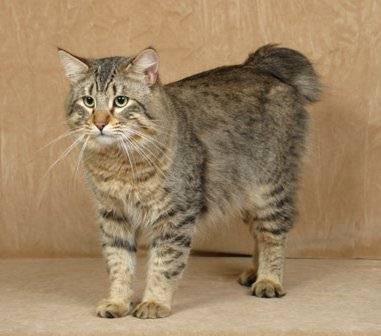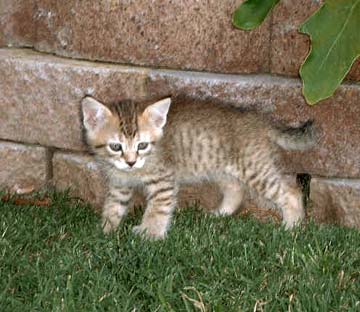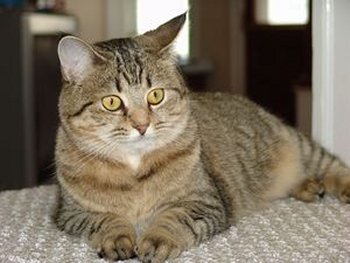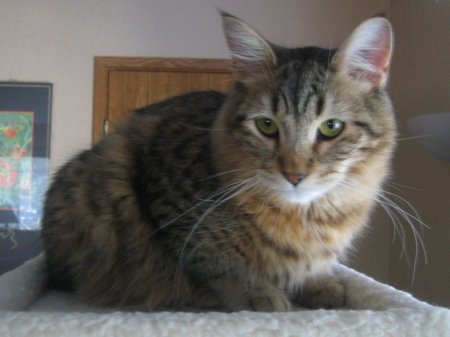



|
Pixiebob Description
The Pixiebob has the appearance of the wild bobcat while being completely domestic. They are bred to resemble the wild coastal bobcat of the Northwestern United States. The head is an inverted pear with medium ears set equally on top and to the side of the head. Lynx tipping is desirable in both long and short coats, as are pale thumbprints on the backs of the ears. The eyes of the Pixiebob should be medium sized and heavily hooded, hidden under a bushy brow one eye width apart. Accepted eye colors are gold, brown or gooseberry green.
The body should be substantial and rangy, medium to large in size with prominent shoulder blades. The legs should be long with hind legs longer than front. The feet should be large and long, and so wide that they appear almost round. This is the only breed where polydactyl (extra toed) feet are permitted.
The tail of the Pixiebob should be short, however it is to be no shorter than two inches and should be no longer than the hock of an extended leg.
The coat comes in both long or a short, and should be soft and dense, lying close to the body and resilient to the touch in all shades of brown spotted tabby in either length.
Pixiebob Temperament
Despite its wild look, the Pixiebob is a completely domestic feline. They are known for the strong bond they create with their families. Affectionate and devoted with a laid back personality they are great for the big, busy family. They are wonderful companions for children, loving to be active. They have a wide variety of communication sounds including chirps, chitters and the occasionally guttural and growly sound.
Pixiebob Care
Caring for a Pixiebob is very simple. They require regular grooming and are an otherwise healthy breed.
Pixiebob History
An American breed, the Pixiebob was discovered in the Northwestern United States and continues to be bred to resemble the wild coastal red bobcat. It is the only breed to be accepted as a polydactyl (extra toes). A newer cat breed, it was discovered by Carol Ann Brewer who purchased a spotted male kitten with a shortened tail in 1985. The next year, she rescued another male with a similar tail. This second male took an interest in a neighbors house cat and the resulting litter had kittens that sported this unique tail. Ms. Brewer selected one of the kittens with a shaggy, reddish coat and named her Pixie. Realizing that these cats had a unique look, she began to look for and bred her own.
In 1993 Ms. Brewer approached TICA with this new breed, named the Pixiebob in memory of the matriarch Pixie and after the bobcat they resemble. TICA accepted them for showing and raised them to Championship status in 1997. There is some controversy concerning the heritage of the Pixiebob; however, despite their appearance, the Pixiebob is a fully domestic cat. Blood tests have confirmed that there are no wild markers in their genetics.
|